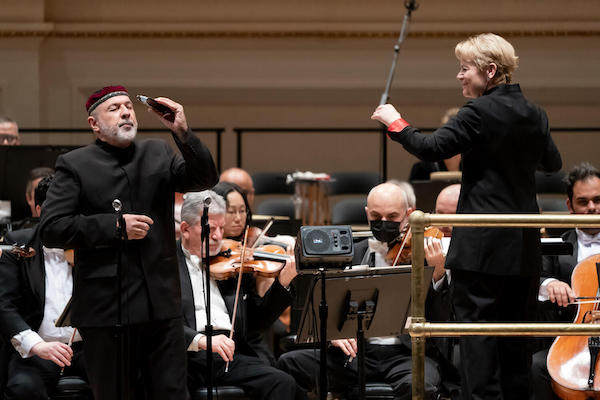São Paolo Symphony shines brightest with Villa-Lobos at Carnegie

When an orchestra comes from far away to visit Carnegie Hall, or only visits infrequently, one anticipates the chance to hear a different sound, even some local quality from their home. Friday night, the São Paolo Symphony Orchestra brought both—at least for half the concert.
With Marin Alsop conducting, and aided by the São Paolo Symphony Choir and a guest soloist, the orchestra played Rimsky-Korsakov’s Scheherazade, and then a sequence of works by Heitor Villa-Lobos in the second half. It was the first half that was disappointing, the second that delivered on all expectations.
Great scores like Scheherazade are something like physics experiments, with notes on the page full of potential energy, ready to be transformed by the musicians. The energy and beauty in the piece should make for a thrilling performance, but this one was just acceptable.
One was impressed with the orchestra’s sound, an unusual combination for this era of dark strings, bronze-hued horns, and excellent, meaty double reeds. That sound promised a lot, and there was plenty of verve in the playing, but not the type of passion and drama that should burst from every moment.
Alsop seemed too focused on controlling details, like the dynamics of the pizzicato string passages, and the transitions to and from the violin solos, but the former limited the tension and the latter were too abrupt. The fast music in the third, Andantino movement did rise to a level of expressive fulfillment—and tempos were good throughout—and as the climax of the final movement approached, the playing did reach a thrilling peak, but the epilogue was again prosaic.
After intermission, the orchestra played the Preludio from Bachianas brasileiras No. 4, and immediately the passion was greater than it had been in the entire first half. Playing the music of this Brazilian composer, the orchestra now had style and élan; where before they followed the score, now they dug into it and brought something out. There was a powerful sense that the music meant something special to them.
The prelude was brief and followed by the most unusual part of the program, Villa-Lobos’ Harmonica Concerto, with José Staneck soloing. The concerto is not Villa-Lobos’ best work, and coming at the end of his life the thematic material in the orchestra often sounds like a first draft. But the solo part is inventive, with unusually long, sinuous melodic lines.
Staneck was excellent with these, spinning out graceful phases. His articulation and the consistency of the rubato in his phrasing were simply beautiful. And though the final Allegro movement is a very thin rondo, Staneck compensated with his encore, an improvisatory journey from a theme from Scheherezade to “The Girl From Ipanema.” The crowd was pleased.
Villa-Lobos’ spectacular Chôros No. 10, with the choir, was the finale. This is a dazzling, almost indescribable work, full of wild energy, popular dance rhythms, and with a fragmented structure that comes together in a logical and elegant form. That form is both through-composed and made up of discrete episodes, like rhythmic fanfares and a theme that sounds like laughter that circulates through the orchestra. It concludes with the setting of a melodramatic poem, “Tear the Heart Apart,” by Catulo da Paixão Cearense. The feeling of the style, with classical techniques and popular music from all over the globe, is like nothing else but Bernstein’s Mass, yet Chôros is from 1926, predating Mass by nearly 50 years.
The performance was skillful, robust, and joyful, with the choir singing with tremendous vigor. The extroverted, populist feel never waned, even in the choral music, which the composer set with punchy, thrusting rhythms and articulations that exceed the original florid text and have the exuberant toughness of a street party. That brought down the house, and Alsop came back out and danced the audience off the floor with some short, orchestral sambas.
The São Paolo Symphony plays Amazon-inspired music by Villa-Lobos, Philip Glass, Clarice Assad, and others, with visual direction by Marcello Dantas, 8 p.m. Saturday. carnegiehall.org



Posted Oct 17, 2022 at 9:56 am by Martha Huggins
Excellent review for an excellent orchestra thank you Martha K Huggins
Posted Oct 17, 2022 at 3:41 pm by Scott Merrell
Nonsense! The performance of Scherazade was inspired and brilliant. The violinist, basoon, oboe and flute soloists were magnificent.